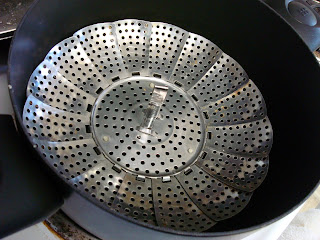"Arty Chokes Three for a Dollar at Food Mart".
How to Shop for Artichokes:
When choosing which artichokes to purchase, look for ones that are a deep green in color and are relatively heavy for their size. The leaves should be tightly formed and "squeak" when pressed. Avoid artichokes that have split leaves, are brown, or have started to open.

How to Store Artichokes:
Artichokes can be refrigerated for up to four days in a plastic bag (unwashed).
How to Cook Artichokes:
There are a variety of ways for one to cook these vegetables. They can be boiled, steamed, stuffed, or microwaved.
Did you know? Artichokes contain copious amounts of phenolic compounds. Phenols are a group of chemical substances found in plants typically characterized by the presence of phenol units. They are constructed from a simple closed ring of six carbon atoms and a hydroxyl unit (-OH). Raw artichoke is very astringent due to these compounds reacting with our salivary proteins. Cooking reduces the astringency by disrupting the cells and casuing the phenolics to bind to different molecules. This lowers the amount of free phenolics that cause astringency. Some phenolics even have antioxidant and cholesterol-lowering effects.
Steamed Artichokes


Artichoke(s)
Garlic
Butter
Lemon
Artichokes have small thorns at the end of the leaves. We do not eat the entire leaf so they are easily avoided; however, some people prefer to remove these thorns. With a scissor snip off the tips of the artichoke leaves. We will also cut off about 1 inch from the tip. Cut off any excess stem.


Rinse the artichoke under cold water.
Fill a large pot with several inches of water and crush a garlic clove (or two) into it. Place a steaming basket in the pot and add the artichokes. They should not be covered with water as we want to steam them, not boil them.

Cover the pot and bring water to a boil. Once a boil is reached, reduce to a simmer and allow to cook for 25 -45 minutes. The time it takes depends on the size of the artichoke. Check occasionally to determine if done. This can be checked by removing the outer leaves. They should be pulled off easily.
An alternate way of steaming is using a pressure cooker. Cooking time is about 15 - 20 minutes.
While we let the artichoke cool for a bit, we can make the dipping sauce!!! Put some butter into a small bowl and melt in the microwave. Add some lemon juice. And we're done!

Pull the leaves off one at a time. Dip the tip of leaf in the butter and scrape off the soft, pulpy part with your teeth.

When we get to the center you will notice a bunch of fuzz (the "choke"). We can scrape this part off with a butter knife or spoon, revealing the heart. The heart is honestly the best, most succulent part of the artichoke. I got overly excited and impatient and ate the heart before I remembered to take a photograph of it. My apologies. Cut into pieces and dip in the butter. Enjoy!
Garlic
Butter
Lemon
Artichokes have small thorns at the end of the leaves. We do not eat the entire leaf so they are easily avoided; however, some people prefer to remove these thorns. With a scissor snip off the tips of the artichoke leaves. We will also cut off about 1 inch from the tip. Cut off any excess stem.


Rinse the artichoke under cold water.
Fill a large pot with several inches of water and crush a garlic clove (or two) into it. Place a steaming basket in the pot and add the artichokes. They should not be covered with water as we want to steam them, not boil them.

Cover the pot and bring water to a boil. Once a boil is reached, reduce to a simmer and allow to cook for 25 -45 minutes. The time it takes depends on the size of the artichoke. Check occasionally to determine if done. This can be checked by removing the outer leaves. They should be pulled off easily.
An alternate way of steaming is using a pressure cooker. Cooking time is about 15 - 20 minutes.
While we let the artichoke cool for a bit, we can make the dipping sauce!!! Put some butter into a small bowl and melt in the microwave. Add some lemon juice. And we're done!

Pull the leaves off one at a time. Dip the tip of leaf in the butter and scrape off the soft, pulpy part with your teeth.

When we get to the center you will notice a bunch of fuzz (the "choke"). We can scrape this part off with a butter knife or spoon, revealing the heart. The heart is honestly the best, most succulent part of the artichoke. I got overly excited and impatient and ate the heart before I remembered to take a photograph of it. My apologies. Cut into pieces and dip in the butter. Enjoy!




No comments:
Post a Comment